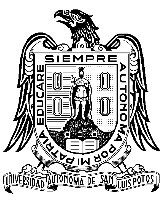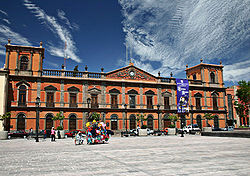
Universidad Autónoma de San Luis Potosí
Encyclopedia
The Autonomous University of San Luis Potosí (in Spanish: Universidad Autónoma de San Luis Potosí, UASLP) is a public university
in Mexico
. It is the largest university in the state of San Luis Potosí
. Among other historic milestones, in 1923 UASLP was the first university in Mexico to have autonomy constitutionally granted.
 The oldest antecedent of UASLP is a Jesuit
The oldest antecedent of UASLP is a Jesuit
college founded in 1624 in the city of San Luis Potosí
to teach literacy, secondary and high school studies. In 1625 governor Ildefonso Díaz de León was directly involved in the creation of the Colegio Guadalupano Josefino. Opening on 2 June 1626, the college initially included academic programs in Humanities
, Philosophy
, Theology
and Law
. A Medicine
program was added six years later. The first rector
was Manuel María de Gorriño y Arduengo. Unfortunately, teachers were not always available and due to political and civil unrest there were times, especially in the 1800s, the college had to suspend classes on a temporary basis. Also, in 1855 the Medicine program was closed.kml
During the Mexican Revolution
, when some properties of the Roman Catholic Church
were seized, the main college buildings (including the library and the astronomical observatory) were confiscated from the Church. However, the college continued working although only the Instituto Científico y Literario was able to grant degrees.
On 10 January 1923, governor Rafael Nieto issued Decree No. 106, which established the University of San Luis Potosí. The academic structure of the new institution included the faculties of Medicine, Law, Chemistry and Business. It also included the Civil Hospital, the San Luis Potosi Public Library, the State Meteorological Observatory, and the normal school
for training teachers. The 1923 Decree granted autonomy to the University.
More recently, in 1949, the Decree Number 53, under Article 100 of the Political Constitution of the State of San Luis Potosi, changed the name of the institution into its current one of Autonomous University of San Luis Potosi.
Public university
A public university is a university that is predominantly funded by public means through a national or subnational government, as opposed to private universities. A national university may or may not be considered a public university, depending on regions...
in Mexico
Mexico
The United Mexican States , commonly known as Mexico , is a federal constitutional republic in North America. It is bordered on the north by the United States; on the south and west by the Pacific Ocean; on the southeast by Guatemala, Belize, and the Caribbean Sea; and on the east by the Gulf of...
. It is the largest university in the state of San Luis Potosí
San Luis Potosí
San Luis Potosí officially Estado Libre y Soberano de San Luis Potosí is one of the 31 states which, with the Federal District, comprise the 32 Federal Entities of Mexico. It is divided in 58 municipalities and its capital city is San Luis Potosí....
. Among other historic milestones, in 1923 UASLP was the first university in Mexico to have autonomy constitutionally granted.
History

Society of Jesus
The Society of Jesus is a Catholic male religious order that follows the teachings of the Catholic Church. The members are called Jesuits, and are also known colloquially as "God's Army" and as "The Company," these being references to founder Ignatius of Loyola's military background and a...
college founded in 1624 in the city of San Luis Potosí
San Luis Potosí, San Luis Potosí
San Luis Potosí, commonly called SLP or simply San Luis, is the capital of, and most populous city in the Mexican state of the same name. The city lies at an elevation of 1,850 meters...
to teach literacy, secondary and high school studies. In 1625 governor Ildefonso Díaz de León was directly involved in the creation of the Colegio Guadalupano Josefino. Opening on 2 June 1626, the college initially included academic programs in Humanities
Humanities
The humanities are academic disciplines that study the human condition, using methods that are primarily analytical, critical, or speculative, as distinguished from the mainly empirical approaches of the natural sciences....
, Philosophy
Philosophy
Philosophy is the study of general and fundamental problems, such as those connected with existence, knowledge, values, reason, mind, and language. Philosophy is distinguished from other ways of addressing such problems by its critical, generally systematic approach and its reliance on rational...
, Theology
Theology
Theology is the systematic and rational study of religion and its influences and of the nature of religious truths, or the learned profession acquired by completing specialized training in religious studies, usually at a university or school of divinity or seminary.-Definition:Augustine of Hippo...
and Law
Law
Law is a system of rules and guidelines which are enforced through social institutions to govern behavior, wherever possible. It shapes politics, economics and society in numerous ways and serves as a social mediator of relations between people. Contract law regulates everything from buying a bus...
. A Medicine
Medicine
Medicine is the science and art of healing. It encompasses a variety of health care practices evolved to maintain and restore health by the prevention and treatment of illness....
program was added six years later. The first rector
Rector
The word rector has a number of different meanings; it is widely used to refer to an academic, religious or political administrator...
was Manuel María de Gorriño y Arduengo. Unfortunately, teachers were not always available and due to political and civil unrest there were times, especially in the 1800s, the college had to suspend classes on a temporary basis. Also, in 1855 the Medicine program was closed.kml
During the Mexican Revolution
Mexican Revolution
The Mexican Revolution was a major armed struggle that started in 1910, with an uprising led by Francisco I. Madero against longtime autocrat Porfirio Díaz. The Revolution was characterized by several socialist, liberal, anarchist, populist, and agrarianist movements. Over time the Revolution...
, when some properties of the Roman Catholic Church
Roman Catholic Church
The Catholic Church, also known as the Roman Catholic Church, is the world's largest Christian church, with over a billion members. Led by the Pope, it defines its mission as spreading the gospel of Jesus Christ, administering the sacraments and exercising charity...
were seized, the main college buildings (including the library and the astronomical observatory) were confiscated from the Church. However, the college continued working although only the Instituto Científico y Literario was able to grant degrees.
On 10 January 1923, governor Rafael Nieto issued Decree No. 106, which established the University of San Luis Potosí. The academic structure of the new institution included the faculties of Medicine, Law, Chemistry and Business. It also included the Civil Hospital, the San Luis Potosi Public Library, the State Meteorological Observatory, and the normal school
Normal school
A normal school is a school created to train high school graduates to be teachers. Its purpose is to establish teaching standards or norms, hence its name...
for training teachers. The 1923 Decree granted autonomy to the University.
More recently, in 1949, the Decree Number 53, under Article 100 of the Political Constitution of the State of San Luis Potosi, changed the name of the institution into its current one of Autonomous University of San Luis Potosi.
Organization
UASLP is organized in faculties, schools, coordinations, academic units and departments; it is divided into 12 faculties, 2 schools, 2 coordinations, 2 departments and 2 academic units for different and specific areas. Both undergraduate and graduate studies are available on each faculty. To date, UASLP has a student population of more than 32,000 people, and offers 73 undergraduate programs .Faculties
- Faculty of Accounting and Administration
- Faculty of Agronomy
- Faculty of Chemistry
- Faculty of Economics
- Faculty of Engineering
- Faculty of Law
- Faculty of Medicine
- Faculty of Nursing
- Faculty of Psychology
- Faculty of Sciences
- Faculty of Stomatology
- Faculty of the Habitat (for architecture, design and building related studies)
Coordinations
- Coordination of Human Studies and Social Sciences
- Academic Coordination, Altiplano Region (MatehualaMatehualaMatehuala is the fourth-largest city in the Mexican state of San Luis Potosí. It is located at around , at an elevation of about 1,500 m. Matehuala is also the municipal seat of the municipality of the same name, located in the northern part of the state, on the border with the southwestern...
)
Academic units
- Multidisciplinary Academic Unit, Huastec Region (Ciudad VallesCiudad VallesCiudad Valles is the second-largest city in the Mexican state of San Luis Potosí. It is located in the eastern part of the state at . The city is also the municipal seat of the surrounding municipality of the same name. The city had a 2005 census population of 116,261, while the municipality's...
) - Multidisciplinary Academic Unit, Media Region (Rio Verde)
Notable alumni
- Ponciano ArriagaPonciano ArriagaPonciano Arriaga was a lawyer and politician from San Luis Potosí.Arriaga rose to prominence in the late 1840s and is particularly known for pushing for the equality of people through property rights. Arriaga proposed a law in which the government would confiscate lands from the local hacienda...
(1811–1863), lawyer and Constitutional Congressman. - Manuel José OthónManuel José OthónManuel José Othón was a poet, playwright, and Mexican politician. One of his most famous works is Idilio salvaje considered one of the most representative poems of Mexico....
(1858–1906), poet - Francisco de Asís Castro, poet
- Manuel Herrera y Lasso, law professor, writer and politician
- Primo Feliciano VelázquezPrimo Feliciano VelázquezPrimo Feliciano Velázquez Rodríguez was a Mexican journalist, attorney and historian who specialized in regional history. He was a translator of Nahuatl and Latin and a connoisseur of local literature...
, historian - Luis Ernesto DerbezLuis Ernesto DerbezLuis Ernesto Derbez Bautista is a Mexican politician and current rector of the Universidad de Las Américas.Upon assuming power in December 2000, President Vicente Fox chose him to serve as his Secretary of Economy...
(1947-), Mexico's Secretary of Foreign Affairs 2003-2006 - Dos Caras, Jr. (1977-), professional wrestler otherwise known as Alberto Del Rio.

